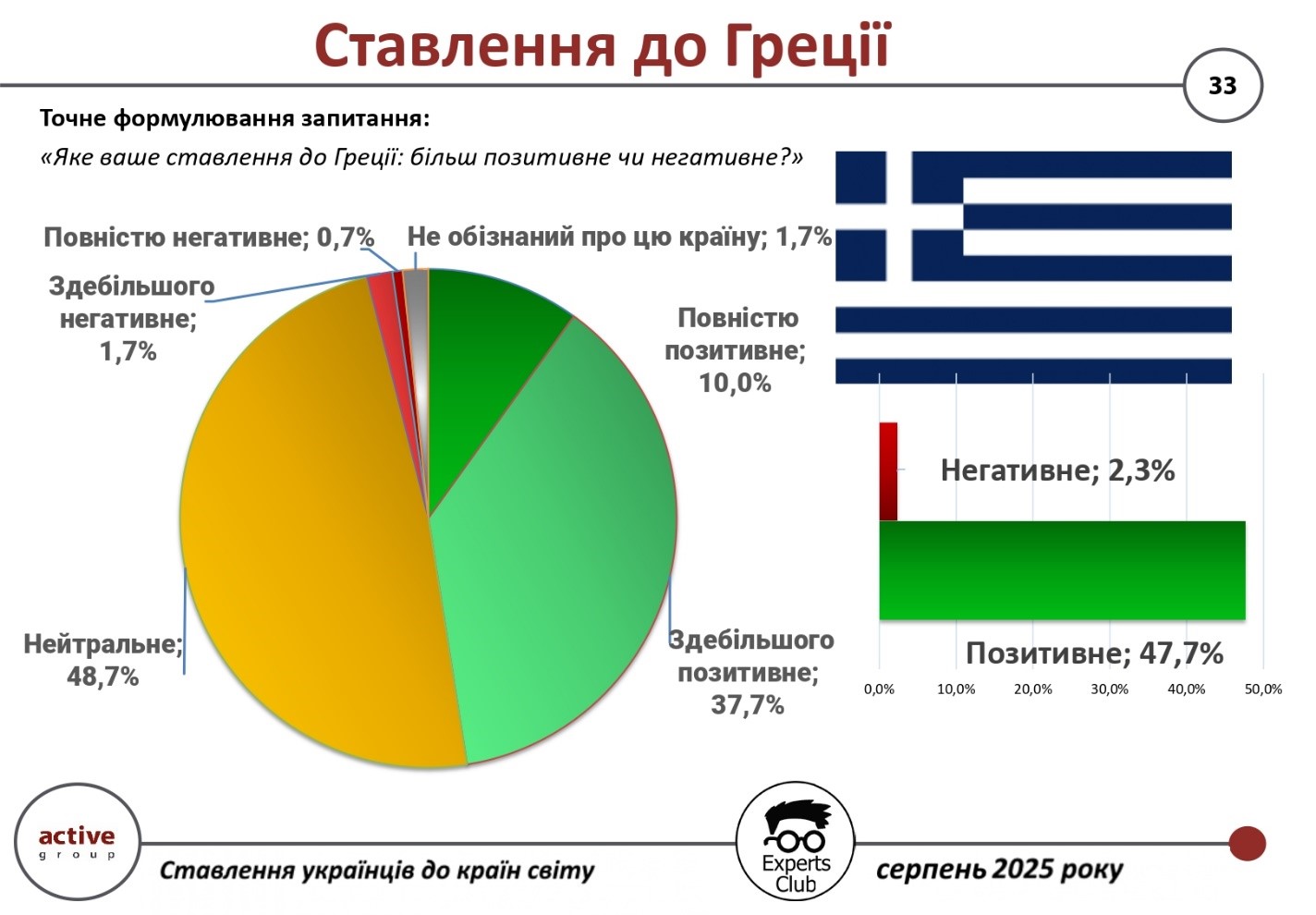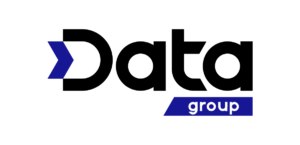
The attitude of Ukrainians towards Greece remains largely positive, although almost half of the respondents express a neutral position. This is evidenced by the results of a nationwide sociological survey conducted by Active Group in collaboration with the information and analytical center Experts Club in August 2025.
According to the study, 47.7% of Ukrainians have a positive attitude towards Greece (37.7% — mostly positive, 10.0% — completely positive). Only 2.3% of respondents rated the country negatively (1.7% — mostly negative, 0.7% — completely negative). At the same time, 48.7% of citizens remain neutral, and 1.7% admitted that they do not have enough information about this country.
“For Ukrainians, Greece is primarily associated with cultural heritage, tourism, and historical proximity to European traditions. This creates a generally positive image, although not as pronounced as in the case of Ukraine’s strategic partners,” commented Active Group co-founder Oleksandr Pozniy.

In turn, Maksim Urakin, founder of Experts Club, emphasized the economic aspect of the relationship:
“In the first half of 2025, trade turnover between Ukraine and Greece exceeded $784 million. At the same time, exports from Ukraine amounted to only $193.8 million, while imports from Greece reached over $590 million.
The negative balance of approximately $397 million indicates a significant trade imbalance, which is of strategic importance for the further development of bilateral economic relations,” he said.
The survey is part of a broader study analyzing the international sympathies and antipathies of Ukrainians in the current geopolitical context.
The full video can be viewed at: https://www.youtube.com/watch?v=YgC9TPnMoMI&t
You can subscribe to the Experts Club YouTube channel here: https://www.youtube.com/@ExpertsClub
ACTIVE GROUP, DIPLOMACY, EXPERTS CLUB, GREECE, Pozniy, SOCIOLOGY, TRADE, URAKIN

Dreame, a manufacturer of innovative cleaning and hair care appliances, is opening its first showroom in Ukraine at Lavina Mall (6D Berkovetska Street), according to the mall’s press service.
The opening of the showroom is scheduled for October 11-12.
“We are confident that the interactive Dreame showroom will not only strengthen the pool of tenants in the technology and electronics category, but also provide visitors with a unique customer experience that meets the highest standards of modern retail,” commented Inna Dzyadzin, leasing director at Mandarin Plaza Group.
Unlike a traditional store, the 53 sq. m Dreame showroom is designed as an interactive zone where visitors can try out the appliances in action. To this end, several themed corners have been set up: a robot vacuum cleaner zone, a vertical vacuum cleaner section, and a beauty zone with hair care devices.
The Dreame brand is a sub-brand of Chinese giant Xiaomi, founded in 2017 and quickly gaining popularity around the world thanks to its combination of high technology, modern design, and focus on the real needs of users. Today, Dreame products are available in more than 100 countries, and the opening of the first showroom in Ukraine is another step in the company’s global development.

Most Ukrainians express a positive attitude towards Switzerland, although a significant proportion of respondents remain neutral. This is evidenced by the results of a nationwide sociological survey conducted by Active Group in collaboration with the information and analytical center Experts Club in August 2025.
According to the data, 60.3% of Ukrainians have a positive opinion of Switzerland (42.0% — mostly positive, 18.3% — completely positive). Only 1.7% of respondents expressed a negative attitude (1.3% — mostly negative, 0.3% — completely negative). At the same time, 36.7% remain neutral, and 1.7% said they did not have enough information about the country.
“Ukrainians associate Switzerland with reliability, stability, and humanitarian support, which the country provides in difficult times. The high level of trust indicates Switzerland’s positive image, despite a certain detachment in global politics,” commented Active Group co-founder Oleksandr Pozniy.

In turn, Maksim Urakin, founder of Experts Club, emphasized economic ties:
“In the first half of 2025, trade turnover between Ukraine and Switzerland exceeded $928 million. At the same time, Ukrainian exports amounted to only $44 million, while imports from Switzerland reached almost $884 million. The negative balance of more than $839 million is significant, indicating Ukraine’s substantial dependence on imports from this country,” he stressed.
The survey was part of a broader program of research into the international sympathies and antipathies of Ukrainians in the current geopolitical context.
The full video can be viewed at: https://www.youtube.com/watch?v=YgC9TPnMoMI&t
You can subscribe to the Experts Club YouTube channel here: https://www.youtube.com/@ExpertsClub
ACTIVE GROUP, DIPLOMACY, EXPERTS CLUB, Pozniy, SOCIOLOGY, SWITZERLAND, TRADE, URAKIN

Goodwell Ukraine, a large agricultural company owned by Danish investors, has received permission from the Antimonopoly Committee of Ukraine (AMCU) to acquire a controlling stake in the private enterprise Agro-Vita. The decision was made on September 18, according to the AMCU press service.
According to the document, Goodvalley Ukraine will be able to acquire more than 50% of the votes in Agro-Vita’s highest governing body. Both companies are registered and operate in the Ivano-Frankivsk region.
Agro-Vita specializes in growing grains, legumes, and oilseeds.
Goodvalley Ukraine is part of the international Goodvalley group, founded in Denmark. The company has been operating in Ukraine since 2004, engaged in livestock breeding (pig and cattle breeding), crop production, and compound feed production. The company’s main facilities are located in the Ivano-Frankivsk region, where Goodvalley has invested tens of millions of euros in the development of agricultural production, environmental projects, and social programs for local communities.
The company previously announced that it plans to expand the processing of agricultural products and introduce modern technologies for sustainable agriculture.
The Goodvalley Group operates in more than ten European countries. In Ukraine, it is one of the largest foreign agricultural investors. The company’s development is seen as an important signal of continued investment interest from the EU even in the context of war, which helps to maintain employment in rural areas and strengthen the country’s food security.

Scientists are increasingly turning their attention to an unusual means of improving brain health: silence. According to research, regular exposure to complete silence can stimulate the growth of new brain cells, reduce stress levels, and improve cognitive function.
This was first pointed out by a study by neurobiologist Imke Kirste from Duke University (USA). An experiment on mice showed that two hours of silence a day — not music or noise — leads to a significant increase in the number of neurons in the hippocampus, which is responsible for memory and learning. This was a sensation, as it had long been believed that the adult brain had virtually no capacity for neurogenesis.
In humans, silence activates the so-called default mode network (a network of passive brain activity) that turns on when we are not engaged in external tasks. At this moment, the brain structures information, strengthens memory, and initiates restorative processes. In addition, changes in brain waves are recorded: a transition from “fast” beta rhythms to calmer alpha and theta waves associated with creativity and reduced anxiety.
Similar conclusions are confirmed by studies of mindfulness and meditation practices. In 2011, Harvard proved that an eight-week Mindfulness-Based Stress Reduction program increases gray matter density in the hippocampus.
Silence affects more than just the brain:
1) it lowers cortisol levels and normalizes blood pressure and heart rate;
2) it improves concentration and cognitive clarity;
3) it helps regulate sleep and emotional state;
4) it creates conditions for creative ideas to emerge.
According to psychologists, “silence is not emptiness, but a space of presence” that helps restore balance and clarity. Thus, two hours of silence a day — whether it’s a walk without gadgets, meditation practice, or simply disconnecting from background noise — can be a powerful tool for brain and body health.

Datagroup, a telecommunications operator that has been part of the DVL group of companies (Datagroup-Volia-lifecell) since September 2024, earned UAH 78.58 million in net profit in January-June 2025, compared to a net loss of UAH 43.05 million in the same period last year.
According to the company’s financial report in the NSSMC disclosure system, the company increased its revenue by 14% to UAH 917.40 million during the reporting period, while gross profit decreased by 3.2% to UAH 267.72 million, and operating profit decreased by 37.7% to UAH 75.34 million.
According to the report, the return to profitability is explained by a reduction in financial expenses in the first half of this year to UAH 7.94 billion from UAH 163.8 billion in the first half of last year.
“The company’s current financial and economic condition remains resilient to the challenges of large-scale war in Ukraine,” the report says.
The company added that in order to minimize negative effects and increase business efficiency, work is continuing on “intra-group corporate integration processes aimed at reducing operating and capital expenditures for the modernization of the electronic communications network and improving the quality of electronic communications services.”
During the reporting period, the average number of full-time employees was 1,524, with 85 part-time employees and 113 part-time employees. Payroll expenses in the second quarter of 2025 amounted to UAH 284.15 million, and compared to the previous year, the payroll fund increased.
The DVL Group of Companies noted in its release that in the first half of 2025, profitability increased by 30% compared to the second half of 2024. Since the beginning of the integration of the group’s companies, lifecell’s EBITDA margin has increased by 7 p.p. and reached 58.4% in the second quarter of 2025.
As reported, in September 2024, NJJ Holding, led by French investor Xavier Niel, completed the acquisition of national fixed-line internet service provider Datagroup-Volia and third-largest mobile operator lifecell. The assets were merged into the DVL group.